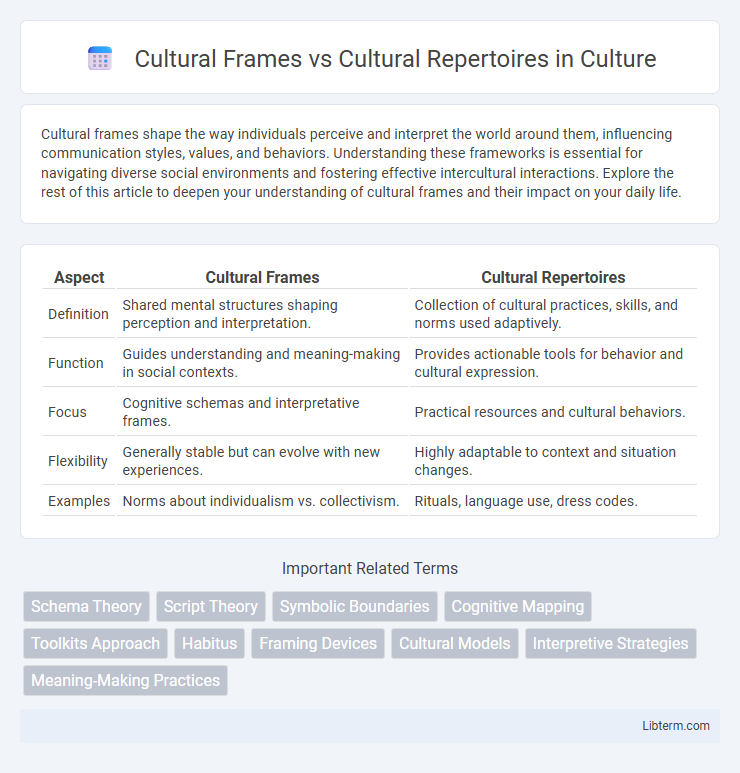Cultural frames shape the way individuals perceive and interpret the world around them, influencing communication styles, values, and behaviors. Understanding these frameworks is essential for navigating diverse social environments and fostering effective intercultural interactions. Explore the rest of this article to deepen your understanding of cultural frames and their impact on your daily life.
Table of Comparison
| Aspect | Cultural Frames | Cultural Repertoires |
|---|---|---|
| Definition | Shared mental structures shaping perception and interpretation. | Collection of cultural practices, skills, and norms used adaptively. |
| Function | Guides understanding and meaning-making in social contexts. | Provides actionable tools for behavior and cultural expression. |
| Focus | Cognitive schemas and interpretative frames. | Practical resources and cultural behaviors. |
| Flexibility | Generally stable but can evolve with new experiences. | Highly adaptable to context and situation changes. |
| Examples | Norms about individualism vs. collectivism. | Rituals, language use, dress codes. |
Understanding Cultural Frames: Definition and Examples
Cultural frames are mental structures that shape how individuals perceive and interpret social situations, guiding behavior and communication within specific cultural contexts. These frames influence norms, values, and expectations, such as the individualism frame prevalent in Western societies or the collectivism frame dominant in many Asian cultures. Understanding cultural frames helps decode implicit meanings in interactions, enhancing cross-cultural competence and reducing misunderstandings.
Defining Cultural Repertoires in Social Contexts
Cultural repertoires in social contexts refer to the dynamic set of skills, symbols, narratives, and practices that individuals and groups draw upon to navigate social interactions and express identity. Unlike fixed cultural frames, repertoires are flexible and context-dependent, enabling adaptation to evolving social environments and power structures. This concept highlights how culture is actively constructed and mobilized rather than passively inherited.
Key Differences Between Cultural Frames and Repertoires
Cultural frames are cognitive structures that shape how individuals interpret and respond to social events, emphasizing mental schemas and perspectives within a culture. In contrast, cultural repertoires consist of a range of practices, behaviors, and symbols available to individuals to navigate social situations, highlighting tangible cultural resources. Key differences lie in frames providing interpretive lenses, while repertoires offer actionable tools for cultural expression and adaptation.
Theoretical Foundations: Frame Analysis vs Repertoire Theory
Cultural Frames are rooted in Frame Analysis, a theoretical approach developed by Erving Goffman that emphasizes how individuals interpret and organize experiences through schemas shaping perception and behavior. In contrast, Cultural Repertoires draw from Repertoire Theory, which highlights a set of adaptable cultural tools, practices, and symbols individuals use contextually to navigate social life and express identity. While Frame Analysis focuses on cognitive structures influencing meaning-making, Repertoire Theory centers on the practical selection of cultural elements available within a community's dynamic social environment.
Cultural Frames in Everyday Decision-Making
Cultural frames shape everyday decision-making by providing individuals with implicit guidelines and mental models rooted in shared values, beliefs, and norms within a culture. These frames influence perception and interpretation of situations, enabling swift judgments and actions that align with cultural expectations. Understanding cultural frames is essential for analyzing behavior patterns and predicting responses in social interactions across diverse cultural contexts.
Repertoires as Toolkits: Navigating Social Situations
Cultural repertoires serve as flexible toolkits comprising diverse norms, practices, and symbols that individuals draw upon to navigate complex social situations effectively. Unlike fixed cultural frames, repertoires provide strategic options enabling adaptation to varying contexts and interactions. This dynamic utilization of cultural elements facilitates social negotiation, identity expression, and problem-solving within multicultural environments.
The Role of Context: When Frames and Repertoires Intersect
Cultural frames shape how individuals interpret social phenomena by providing specific lenses influenced by historical and social contexts, while cultural repertoires encompass the range of practices and expressions available within a culture. The role of context becomes crucial when frames and repertoires intersect, as situational factors determine which cultural scripts are activated and how meanings are negotiated. Understanding this dynamic interaction enhances analyses of identity, communication, and social behavior across diverse cultural settings.
Implications for Identity and Group Dynamics
Cultural frames shape individuals' perceptions and interpretations within a social context, directly influencing identity formation by providing shared meanings and norms that guide group behavior. Cultural repertoires consist of a range of practices, symbols, and narratives that individuals can draw upon flexibly, enabling dynamic negotiation of identity and fluid group affiliations. The interaction between fixed cultural frames and adaptable repertoires affects group dynamics by either reinforcing cohesion through common understandings or facilitating diversity through multiple identity expressions.
Methodologies for Studying Frames and Repertoires
Methodologies for studying cultural frames often employ qualitative content analysis, discourse analysis, and ethnographic approaches to unpack how individuals interpret and communicate shared meanings within specific contexts. In contrast, cultural repertoire studies frequently utilize mixed methods, combining survey data, in-depth interviews, and social network analysis to map the range of symbolic resources and practices individuals draw upon in various social situations. Comparative approaches leveraging computational text mining and longitudinal ethnomethodological studies further enhance the understanding of the dynamic interactions between cultural frames and repertoires across diverse populations.
Applications in Multicultural and Global Settings
Cultural frames guide individuals' interpretations based on shared societal values, shaping perception and communication in multicultural and global settings. Cultural repertoires encompass the diverse set of behaviors, symbols, and practices individuals can draw upon to navigate cross-cultural interactions effectively. Applying these concepts enhances intercultural competence, facilitating negotiation, collaboration, and conflict resolution across diverse cultural landscapes.
Cultural Frames Infographic

 libterm.com
libterm.com